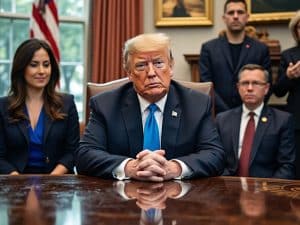Crypto Futures Trading: How To Start And What Are The Risks?

Crypto Futures Trading: How To Start And What Are The Risks?
Crypto futures trading is a financial instrument that allows traders to speculate on the future price of cryptocurrencies without actually owning them. It’s an agreement to buy or sell a specific amount of a cryptocurrency at a predetermined price at a specified time in the future. This tool is popular among traders looking to hedge against price volatility or to profit from price movements in the crypto market. Here’s a breakdown of the key aspects of crypto futures trading:
What are Futures Contracts?
A futures contract is a standardized agreement between two parties to buy or sell an asset (in this case, a cryptocurrency) at a predetermined future date and price. The buyer of the contract agrees to buy the asset at the contract price on the expiration date, while the seller agrees to provide it.
One of the key features of futures trading is the use of leverage. Leverage allows traders to control a large position with a relatively small amount of capital. For instance, with a 10:1 leverage, you can control $10,000 worth of assets with only $1,000. While leverage can amplify profits, it also increases the risk of significant losses, especially in the volatile crypto market.
That’s why liquidation in crypto futures trading is a critical concept. Liquidation occurs when a trader’s position is automatically closed by the exchange because the value of their account falls below the required maintenance margin level. This happens when the market moves against the trader’s position and the losses exceed the amount of margin (collateral) they have put up to open and maintain that position.
The primary purpose of liquidation is to prevent the trader’s losses from exceeding their initial margin. It also protects the exchange from the risk of the trader being unable to cover their losses, especially important in the highly volatile crypto market.
When a position is liquidated, the trader loses the entire amount of their initial margin, and the position is closed at the current market price. In a rapidly moving market, there can also be a scenario called “slippage,” where the position is closed at a worse price than expected, potentially increasing the loss.
Understanding Long and Short Positions
In the world of trading, whether it’s stocks, commodities, or cryptocurrencies, understanding the concepts of long and short positions is kinda crucial for navigating the markets effectively. These two fundamental strategies form the bedrock of trading activities and offer traders a spectrum of opportunities to capitalize on market movements.
Long positions, often associated with a bullish outlook, involve buying an asset with the expectation that its value will rise over time, allowing the trader to sell it at a higher price. On the other hand, short positions, reflecting a bearish perspective, entail selling an asset not currently owned with the intention to repurchase it at a lower price. Each approach embodies a distinct market view and risk profile, offering traders diverse ways to engage with the market’s ebb and flow.
How are Futures Contracts Settled?
In cryptocurrency futures trading, the settlement of futures contracts is typically streamlined compared to traditional futures markets like commodities or equities. Given the digital nature of cryptocurrencies, these contracts are usually settled in cash rather than physical delivery. Here’s how it works in the context of crypto futures:
Cash Settlement in Crypto Futures:
Cash settlement in crypto futures means the contract is settled in cash, not by exchanging the physical cryptocurrency. The settlement is based on the difference between the contract price and the market price of the cryptocurrency at the time of settlement.
On the expiration date of the futures contract, the final settlement price is determined based on predefined criteria (like the average price over a certain period on specific exchanges). If the settlement price is higher than the contract price, the seller pays the difference to the buyer. If it’s lower, the buyer pays the difference to the seller.
Early Closure of Positions:
Similar to traditional futures markets, many traders in the crypto futures market choose to close their positions before the contract’s expiration date. This allows them to realize profits or losses based on the market price at the time of closing the position, without waiting for the settlement date.
This practice offers traders the flexibility to react to market movements and adjust their strategies without being bound to the contract’s original expiration timeline.
Where do you trade crypto futures contracts and how do you start?
Crypto futures are traded on various exchanges, which could be traditional ones offering cryptocurrency products or specialized crypto exchanges. These exchanges set the margin requirements and other trading parameters. Regulatory oversight varies by jurisdiction and can significantly affect the trading of crypto futures.
- Select a cryptocurrency exchange that offers futures trading. Look for factors like reputation, security, trading volumes, the variety of available futures contracts, fee structures, and customer support. Some popular exchanges for trading crypto futures include Binance, BitMEX, CME Group, and Kraken.
- Create an account on the chosen exchange. You’ll need to go through a verification process (KYC) depending on the exchange and jurisdiction. Once your account is set up, deposit funds into it. Most exchanges accept deposits in both cryptocurrencies and fiat currencies.
- Many exchanges offer demo accounts where you can practice trading futures without risking real money. Use this opportunity to get familiar with the trading platform and your trading strategy.
- Once you are ready, start trading. Choose the cryptocurrency futures contract you want to trade. Decide whether you want to go long (buy) if you anticipate prices will rise, or go short (sell) if you expect prices to fall. Enter your trade size and apply any desired leverage.
Regularly monitor your open positions, as cryptocurrency markets can be highly volatile. Be prepared to make adjustments to your positions as needed, and always be aware of your margin balance to avoid liquidation.
You can close your position anytime before the expiration of the contract. If you are in profit, you might want to secure your gains; if you are at a loss, you might decide to cut your losses. Some traders also close their positions to re-enter at a more favorable price.
What risks do you run?
Crypto futures trading is complex and carries significant risk, particularly due to the inherent volatility of cryptocurrencies. The use of leverage can lead to large gains or losses. Traders need to be well-versed in market analysis and risk management. It’s also crucial to understand the contract terms and conditions of the exchange being used.
Crypto futures trading offers a way for traders to speculate on cryptocurrency prices and hedge against risks but requires a good understanding of the market and careful risk management due to its complex and high-risk nature.
Here are a few tips for success:
- Start Small: Begin with smaller trades until you gain more experience and confidence.
- Use Stop Losses: This tool can help limit potential losses.
- Avoid Emotional Trading: Make decisions based on analysis and strategy, not on fear or greed.
- Diversify: Don’t put all your funds into one trade or one type of asset.
- Stay Informed: Keep up with the latest news and trends in the crypto market.
5 hypothetical cases of crypto futures trading
Below we’ll give you a few hypothetical scenarios illustrating different approaches and outcomes in cryptocurrency futures trading. We will show you various strategies, risks, and decision-making processes involved in this type of trading.
Case 1: Successful Long Position Trade
- Scenario: Alice believes that the price of Bitcoin will increase in the next few months due to a positive market sentiment and upcoming technological upgrades.
- Action: She enters a long position on Bitcoin futures with a moderate amount of leverage.
- Outcome: The price of Bitcoin rises as predicted. Alice closes her position at a significant profit. She successfully managed her risk with a stop-loss order and did not get greedy, exiting the trade at a predetermined profit target.
Case 2: Short Position Gone Wrong
- Scenario: Bob anticipates that the price of Ethereum will drop due to a delay in a network upgrade.
- Action: He enters a short position on Ethereum futures with high leverage.
- Outcome: Contrary to Bob’s expectations, the market reacts positively to the delay, seeing it as a sign of thorough development. The price of Ethereum rises sharply, and Bob’s position is liquidated due to the high leverage, resulting in a substantial loss.
Case 3: Hedging with Futures
- Scenario: Carla holds a significant amount of Ripple (XRP) and is concerned about potential short-term price volatility.
- Action: She uses Ripple futures to hedge her position, taking a short futures position that would profit if Ripple’s price falls.
- Outcome: The price of Ripple does fall in the short term, but Carla’s loss on her holdings is offset by the profits from her futures position. Once the market stabilizes, she closes her futures position, effectively minimizing her losses.
Case 4: Speculative Trade Based on News
- Scenario: David sees news about potential regulatory crackdowns on cryptocurrencies in a major economy.
- Action: Expecting a market overreaction, he takes a short position on a broad cryptocurrency index future.
- Outcome: The market reacts strongly to the news, and prices drop temporarily. David closes his position shortly after, capitalizing on the market’s knee-jerk reaction and securing a quick profit.
Case 5: Misjudging Market Sentiment
- Scenario: Emma reads about increasing institutional interest in Bitcoin and assumes this will lead to an immediate price increase.
- Action: She goes long on Bitcoin futures with a considerable portion of her trading capital.
- Outcome: The market does not react as quickly as Emma anticipated. While institutional interest is a positive sign, it does not immediately translate into price action. Emma faces a margin call as her position moves against her, forcing her to close at a loss.
These 5 cases clearly demonstrate the complexity and risks involved in cryptocurrency futures trading. It’s very important that you understand the importance of strategy, market knowledge, and disciplined risk management in order to succeed. If you don’t completely understand how it works, keep on doing research until you fully grasp how it works.
Watch the Big Short and Get Stressed!
For those wanting to know what kind of stress shorting can have foor instance, you will want to watch “The Big Short”, a film that focuses on the 2007-2008 financial crisis, specifically on how a group of savvy investors bet against the U.S. housing market. While the film doesn’t directly deal with futures trading, it is closely related to the concept of taking a “short” position, which is a fundamental aspect of futures trading.








